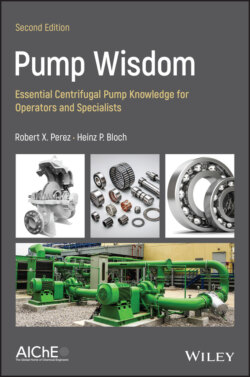Читать книгу Pump Wisdom - Robert X. Perez - Страница 13
Operation at Zero Flow
ОглавлениеThe rate of flow through a pump is labeled Q (gpm) and is plotted on the horizontal axis (the x‐scale). Note that for a given speed and for every value of head H we read off on the y‐axis, there is a corresponding value of Q on the x‐axis. This plotted relationship is expressed as “the pump is running on its curve.” Pump H–Q curves are plotted to commence at zero flow and highest head. Process pumps need a continually rising curve inclination and a curve with a hump somewhere along its inclined line will not serve the reliability‐focused user. Operation at zero flow is not allowed and, if over perhaps a minute's duration, could cause temperature rise and internal recirculation effects that might destroy most pumps.
But remember that this curve is valid only for this particular impeller pattern, geometry, size, and operation at the speed indicated by the manufacturer or entity that produced the curve. Curve steepness or inclination has to do with the number of vanes in that impeller; curve steepness is also affected by the angle each vane makes relative to the impeller hub. In general, curve shape is verified by physical testing at the manufacturer's facility. Once the entire pump is installed in the field, it can be re‐tested periodically by the owner–purchaser for degradation and wear progression. Power draw may have been affected by seals and couplings that differ from the ones used on the manufacturer's test stand. Occasionally, high efficiencies are alluded to in a manufacturer's literature when bearing, seal, and coupling losses are not included in the vendor's test reports.
